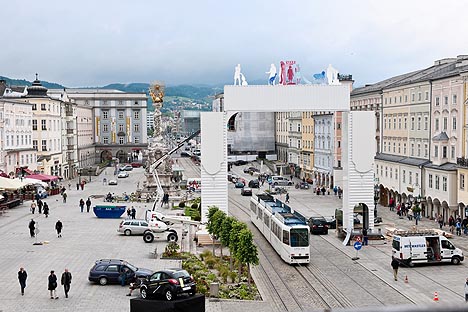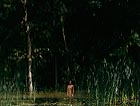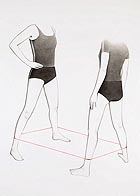
translated and summarized by: Liz Wollner-Grandville,
English summary August 9 - 15
O.K. offenes Kulturhaus Oberösterreich, Landesgalerie Linz am OÖ Landesmuseum, Lentos Kunstmuseum Linz
Triennale Linz 1.0
04.06.10 – 26.09.10
Broad overview, very relaxed
Only recently, in 2009, Linz was awarded the title “Culture Capital” and now the city has set its sails for a new event that takes place every three years: the Triennial Linz 1.0, which offers Austrian artists a platform and is planned to take place until September 29, 2010. The three exhibition venues in Linz: the Lentos, the OK and the Landesgalerie are displaying works by 114 Austrian artists.
On its basement floor, the Lentos is presenting videos that are definitely worth seeing: Adnan Popovic’s animated music video “Laokoongroup” fascinates by combining a great idea with video animation and music and the plot of Synes Elischka’s and Ulrich Kühn’s award-winning “Lifeshow RMX” as well as its symbolism inspire reflection. The show continues on the upper floor, but at first sight the multitude of installations and objects are confusing; yet thanks to Pirmin Blum’s work one also finds a quiet antithesis.
The Landesgalerie presents examples of new Austrian photography depicting landscapes and documentaries that are shaped by personal impressions. They all tell their own stories. Among the highlights is Timotheus Tomicek’s work, which focuses on the pendulum motion between past and present, underlined by this special form of presentation. The quality of his work stands out from the numerous other photographs.
The OK displays diverse works. Among them Florian Hecker’s elegant tuning forks, their design being a perfect example of applied art. They may be used by the museum audience and not only does their unusual sound, which resonates far into the hallways of the OK surprise, but also its theoretical background. At the end of the tour one should not miss the opportunity to lie in Michael Kienzer’s hammock, mounted on the roof of the OK, and muse about the pictures and the justified entry fee for this first exhibition of Austrian art.
By Beate Susanne Wehr
O.K. offenes Kulturhaus Oberösterreich
4020 Linz, Dametzstrasse 30
www.ok-centrum.at
Landesgalerie Linz am OÖ Landesmuseum
4010 Linz, Museumstrasse 14
www.landesgalerie.at
Lentos Kunstmuseum Linz
4020 Linz, Ernst-Koref-Promenade 1
www.lentos.at
Camera Austria
Iosif Király – Reconstructions, Christian Wachter – Impressions d’Afrique
09.07.10 – 05.09.10
A photographic archive as the modus operandi
The fact that photography not only consists of shots and prints that were created by a photographer, but that a photographic archive can play a significant role, is currently proven by the exhibition at the Camera Austria in Graz. The exhibit combines the works by the two artists Christian Wachter and Iosif Király, who use photographic archives as the modus operandi for their artistic work. And even if an archive forms the basis for both their work, their presentations could not be more different.
Christian Wachter’s photographs refer to Raymond Roussel’s literary work “Impressions d’Afrique”, the description of an imaginary Africa, in which European artists are stranded. In a series titled “The Incomparables”, Wachter uses his own photographs as well as photographs taken in Burkina Faso in 1985 depicting people involved in sports and other activities – provided to him through an archive. The sequence of the individual works is mainly based on formalities. The same is applicable to the series “Koda”, dealing with the development of African countries based on the example of Burkina Faso- ranging from its independence movement to its megalomaniac leader.
In “Reconstructions”, also based on a photo archive, Iosif Király assembled individual photos as tableaus and visualized personal recollections. He interprets his pictures as snapshots each representing one byte of stored information; and these bytes are presented on a wall in the classic 9 x 13-format. The design in its entirety is equally impressive as each individual photo, which offers information on selective recollections.
By Nora Theiss
Camera Austria
8020 Graz, Kunsthaus Graz, Lendkai 1
www.camera-austria.at
Galerie Ruzicska
Axel Hütte
17.07.10 - 14.08.10
Paintings before the lens
The most recent works by Axel Hütte, one of Bernd Becher’s students, can be viewed at the Galerie Ruzicska in Salzburg until the middle of September.
The 59-year old artist calls his six-part landscape photograph series - which is currently being presented in Austria for the first time - “Towards the Wood”. Hütte is one of the photographers who had the opportunity to study with Hilla and Bernd Becher in the 70s and 80s, and it seems rather odd that his work has not been presented in Austria earlier. Together with Candida Höfer, Thomas Struth, Andreas Gursky and Thomas Ruff he impressed with his “documentary views” and at first concentrated on shooting municipal ensembles. But already during the 1990’s, he began to focus on details of a building, which, in turn, conveyed his perspective of the entire building.
In Salzburg, large-format photos of trees, ponds, and the remains of snow in waters are displayed that all seem contrived. In some instances, blurred images of naked women, resembling elves or forest spirits, emerge in his works making the photographs appear as if they were digitally manipulated. But in actual fact, as the artist readily explains, these are analogue photos that have been rotated by 180 degrees and thereby irritate the viewer. Hütte is mainly interested in mirroring effects, which he estranges in such a way that the viewer is unable to identify the picture at a first glance. For Hütte, the choice of the detail plays the key role in his work. This choice - and Hütte’s view of this decisive detail - determines the entire composition, and consequently the onlooker’s perspective.
Through photographing wooded landscapes, Hütte comes very close to the art of painting. The broken light on foliage groves, for example, remind of Monet’s water lilies. But also Jackson Pollock’s All-Over principle, come to one’s mind when viewing Hütte’s works. The “Jacobi Gardens”, a winter picture of a pond, reminds of some of Gerhard Richter’s more realistic works. Hütte serves a wide range of art historical details with these very poetic pictures; and German literature, philosophy and music can also be found in his forest pictures. His work is easily associated with the Brother Grimm’s fairy tails, with works by Wilhelm Hauff and songs by Clemens Brentano and Achim von Armin.
With this exhibition, which is soon to be published as a book, Hütte reveals himself as an inspiring artist who offers the onlooker - in the best artistic tradition - an abundance of interpretations. Or simply allows the devotion to sensuous impressions.
By Susanne Rohringer
Galerie Ruzicska
5020 Salzburg, Faistauergasse 12
www.ruzicska.com
Salzburger Kunstverein, Künstlerhaus
Ulrike Lienbacher – Elite bodies // Revolt
22.7.10 – 12.09.10
Focussing on the body
This artist from Salzburg, who is represented by the Gallery Krinzinger in Vienna, centres her work on the female body and its social and psychological attributions.
At first, the large-format drawings of dancers attract one’s attention, later the smaller drawings and photographs. Lienbacher created a panoramic view of her work, which reveals itself to the viewer upon walking through the exhibit. She divided the space with a walk-in cuboid and its mirroring outer wall, in which her videos “Lauf” (Run), “Die Zitrone auspressen” (Squeezing a lemon) and “Coaching/Performance” are shown. It is a black chamber in a white exhibition space – white cube – in which one can look at the motion pictures.
On their stroll through the exhibition, onlookers can look at their own reflection and at the same time find themselves in the “eye of the viewer”, corresponding to the sketches of female bodies displayed on the walls. The viewing subject is simultaneously the object. Lienbacher ingeniously integrates this game of “being seen and seeing” in her presentation.
But Lienbacher not only concentrates on the topic of subject and object. The human body plays the key role: both as a means of expression as well as a projection surface. With the meticulously created sketches she explores the effects of the - naked - body and its special coherences on the basis of photographs. In 2010, she created a series of baryt prints titled “Nude Pensive” dealing with the role of nude models in model classes. The artist supplied the models with books from the 20’s and 30’s, a time in which the body cult reached its first hype.
In her videos, Lienbacher also devotes herself to sports and its merciless competitiveness as a further variation of physicality. In her performance “Coaching” Lienbacher interviews a sports psychologist on high-performance sports and its psychological requirements. And Lienbacher approaches this topic in an uncritical, rather moderate manner. Of course she is mainly concerned with the feministic position of presenting the body as a venue of socio-political processes. But Lienbacher does this in a very modest way, lacking any artistic vehemence. However, a critical approach to the term “elite bodies” oftentimes misused by the Nazis for their ideological perversities is missing.
Nevertheless, Lienbacher’s exhibition in Salzburg is worthwhile seeing.
By Susanne Rohringer
Salzburger Kunstverein/Künstlerhaus
5020 Salzburg, Heilbrunnerstrasse 3
wwww.salzburger-kunstverein.at
Mehr Texte von translated and summarized by: Liz Wollner-Grandville


 Teilen
Teilen






